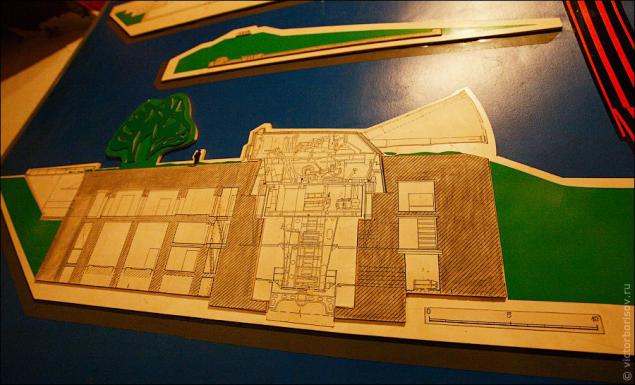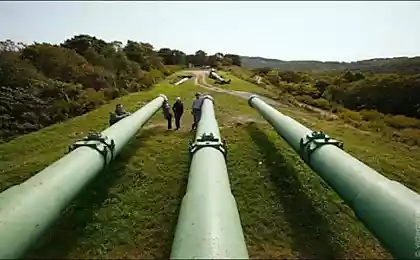1439
Voroshilov battery
"Voroshilov battery" - one of the unique fortifications in the world. The battery is located on the island of Russian in Vladivostok. Similar battery is in Sevastopol. During the reform of the Armed Forces of the Russian Federation in 1997 battery, as a combat unit was disbanded, and its basis was established branch of the Military Historical Museum of the Pacific Fleet "Voroshilov battery».

the spring of 1931 it was decided - to strengthen the defense of Vladivostok. The Commission, headed by the People's Commissar of Defence K. Voroshilov chosen for the new "beachhead" island height near the eastern corner of the bay Novik. Here it was decided to install a tower of 305-mm artillery battery, equipping it with two three-gun bronebashennymi settings with the battleship "Mikhail Frunze" (former battleship "Poltava"). During the 1932-1933. able to perform most of the concrete, rock and underground works. Details of the towers and gun barrels were transported to the island by barge. For transportation of tower structures from m. Polonsky on the bank b. Novik the railroad. Mechanisms and metal to the construction site battery delivered on ice using a tractor scraper. Installation of the first tower was completed February 1, 1934, passed the second two months later.
Weight of the rotating part of each tower - 900 tons, the entire weight of the tower - 1,200 tons. The towers installed armor thickness of 300 mm.

Spare barrels lie nearby. The weight of each barrel - 51 ton. Diameter - 350 mm. Length - about 16 meters.

The rotation of the circular towers. Tilt angles trunks from -5 to +25 degrees. Maximum range of 35 km. The height of the flight path of the projectile at a maximum 11 km. Please note that the battery is completely hidden from view from the sea. And for targeting using a special range finder located a few kilometers away (I will show it later when I talk about the numerous forts).

In the early 1930s, Soviet industry still could not make a 305-mm artillery tower. Therefore, the only right decision was to use the towers of a battleship, not subject to rapid recovery. The thickness of the concrete arch - 3, 5 m. It is designed for a direct hit by bombs weighing 1 ton.

Opened lock guns. 305 mm turret coastal artillery battery was first and last a battery of such a large caliber, built during the Soviet period. Its concrete fortifications were the latest advances military engineering.

The first shot battery produced in 1939, but in fairness I must say that all the batteries were firing Voroshilov training. For example, it could bring down an aircraft carrier one hit, the destroyer - two cruiser - three. Theoretical deviation from the target (at the end of the exercise in 1992) is 1, 5-2 meters, which is considered a high rate even for modern naval technology. Rate for one gun - 1, 5 shots per minute.

Feeder projectile to the barrel.

Bore caliber of 305 mm. Rifled barrel. Obukhov Steel Works, 1916. Here were the same technology at the time.

Technical premises.

The entire complex is impressive in its size. The diagram shows a section of only one of the two towers. In total there are 5 floors underground. The tower is located at a distance of 200 meters from each other and connected by a tunnel.

The battery is in excellent condition, everything works. Once arrived artillery general of the General Staff, and clambered all said that after manning the battery in 2 hours can open fire. Calculation of one tower - 75 people, all of the battery, including the observation point and the power plant, served 399 people.

Shells of different caliber in comparison. One 305 mm caliber projectile weighed 470 pounds (dalneyboyny - 315 kg), and all of them have been here for more than three thousand. Shells types divided into dalneboynye, polubroneboynye and armor that could pierce armor thickness of 350 mm. Could shoot the barrel 1, two, three trunks and all the instruments (6 barrels).

The only thing scary pose - what a shock wave covers all the neighborhoods in the shot. I think, and used for other purposes, these instruments do not have to because no one dared to approach him. From the sea to them not to come, they will destroy the enemy ships before they will be able to make at least one shot. From the air - too difficult.

the spring of 1931 it was decided - to strengthen the defense of Vladivostok. The Commission, headed by the People's Commissar of Defence K. Voroshilov chosen for the new "beachhead" island height near the eastern corner of the bay Novik. Here it was decided to install a tower of 305-mm artillery battery, equipping it with two three-gun bronebashennymi settings with the battleship "Mikhail Frunze" (former battleship "Poltava"). During the 1932-1933. able to perform most of the concrete, rock and underground works. Details of the towers and gun barrels were transported to the island by barge. For transportation of tower structures from m. Polonsky on the bank b. Novik the railroad. Mechanisms and metal to the construction site battery delivered on ice using a tractor scraper. Installation of the first tower was completed February 1, 1934, passed the second two months later.
Weight of the rotating part of each tower - 900 tons, the entire weight of the tower - 1,200 tons. The towers installed armor thickness of 300 mm.

Spare barrels lie nearby. The weight of each barrel - 51 ton. Diameter - 350 mm. Length - about 16 meters.

The rotation of the circular towers. Tilt angles trunks from -5 to +25 degrees. Maximum range of 35 km. The height of the flight path of the projectile at a maximum 11 km. Please note that the battery is completely hidden from view from the sea. And for targeting using a special range finder located a few kilometers away (I will show it later when I talk about the numerous forts).

In the early 1930s, Soviet industry still could not make a 305-mm artillery tower. Therefore, the only right decision was to use the towers of a battleship, not subject to rapid recovery. The thickness of the concrete arch - 3, 5 m. It is designed for a direct hit by bombs weighing 1 ton.

Opened lock guns. 305 mm turret coastal artillery battery was first and last a battery of such a large caliber, built during the Soviet period. Its concrete fortifications were the latest advances military engineering.

The first shot battery produced in 1939, but in fairness I must say that all the batteries were firing Voroshilov training. For example, it could bring down an aircraft carrier one hit, the destroyer - two cruiser - three. Theoretical deviation from the target (at the end of the exercise in 1992) is 1, 5-2 meters, which is considered a high rate even for modern naval technology. Rate for one gun - 1, 5 shots per minute.

Feeder projectile to the barrel.

Bore caliber of 305 mm. Rifled barrel. Obukhov Steel Works, 1916. Here were the same technology at the time.

Technical premises.

The entire complex is impressive in its size. The diagram shows a section of only one of the two towers. In total there are 5 floors underground. The tower is located at a distance of 200 meters from each other and connected by a tunnel.

The battery is in excellent condition, everything works. Once arrived artillery general of the General Staff, and clambered all said that after manning the battery in 2 hours can open fire. Calculation of one tower - 75 people, all of the battery, including the observation point and the power plant, served 399 people.

Shells of different caliber in comparison. One 305 mm caliber projectile weighed 470 pounds (dalneyboyny - 315 kg), and all of them have been here for more than three thousand. Shells types divided into dalneboynye, polubroneboynye and armor that could pierce armor thickness of 350 mm. Could shoot the barrel 1, two, three trunks and all the instruments (6 barrels).

The only thing scary pose - what a shock wave covers all the neighborhoods in the shot. I think, and used for other purposes, these instruments do not have to because no one dared to approach him. From the sea to them not to come, they will destroy the enemy ships before they will be able to make at least one shot. From the air - too difficult.























